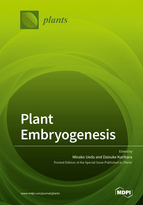Plant Embryogenesis
A special issue of Plants (ISSN 2223-7747). This special issue belongs to the section "Plant Development and Morphogenesis".
Deadline for manuscript submissions: closed (31 December 2020) | Viewed by 32936
Special Issue Editors
Interests: fertilization; parental cooperation; cell polarity; axis formation; pattern formation; transcriptional network
Special Issue Information
Dear Colleagues,
Embryogenesis is a fundamental process in plant ontogeny. The fusion of a paternal sperm and a maternal egg generates a zygote and initiates the series of developmental events to set the basic body plan of the future plant. Therefore, the embryogenesis is a dynamic procedure, involving the shift from the haploid gametophytic to the diploid sporophytic generation, metabolic activation, pattern formation, and dormancy in seed maturation. Furthermore, successful embryogenesis is essential for plant fertility and reproductive fitness. Thus, embryonic regulations are important not only for our understanding of plant evolution and the diversity of survival strategies of various plant species but also for bioengineering to increase plant productivity in agriculture.
Despite intense investigation, there are still various open questions in this fascinating field. For example, our knowledge is still poor about the spatiotemporal dynamics and the regulatory mechanisms of various embryonic events at all levels of whole plants, organs, tissues, cells, and molecules. We also need to understand the generality and diversity of embryonic features in diverse species, and the bioengineering technologies to improve reproductive traits.
Therefore, in this Special Issue, articles (original research papers, perspectives, hypotheses, opinions, reviews, modeling approaches, and methods) are welcomed that focus on plant embryogenesis and its regulation, including through genes, proteins, metabolites, and nutrition. All studies comprising transcriptome, proteome, metabolome, and epigenome, with plant fertility, field trials, and agronomics not only in model plants but also in crop plants, trees, and other species, are most welcome.
Dr. Minako Ueda
Dr. Daisuke Kurihara
Guest Editors
Manuscript Submission Information
Manuscripts should be submitted online at www.mdpi.com by registering and logging in to this website. Once you are registered, click here to go to the submission form. Manuscripts can be submitted until the deadline. All submissions that pass pre-check are peer-reviewed. Accepted papers will be published continuously in the journal (as soon as accepted) and will be listed together on the special issue website. Research articles, review articles as well as short communications are invited. For planned papers, a title and short abstract (about 100 words) can be sent to the Editorial Office for announcement on this website.
Submitted manuscripts should not have been published previously, nor be under consideration for publication elsewhere (except conference proceedings papers). All manuscripts are thoroughly refereed through a single-blind peer-review process. A guide for authors and other relevant information for submission of manuscripts is available on the Instructions for Authors page. Plants is an international peer-reviewed open access semimonthly journal published by MDPI.
Please visit the Instructions for Authors page before submitting a manuscript. The Article Processing Charge (APC) for publication in this open access journal is 2700 CHF (Swiss Francs). Submitted papers should be well formatted and use good English. Authors may use MDPI's English editing service prior to publication or during author revisions.
Keywords
- embryo development
- embryonic productivity
- embryonic viability
- embryo storage
- embryo maturation
- somatic embryo
- embryo–endosperm–sporophyte interactions
- fertilization
- ontogeny
- embryo manipulation
- reproductive trait








